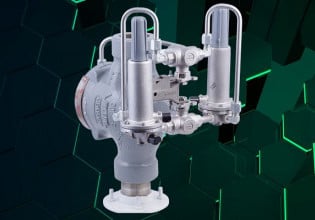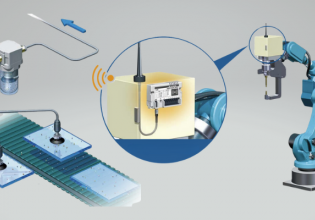How Are Robots Used in the Process Industries?
How are robots used in discrete versus process automation? Can the process industries utilize more robotic automation?
Robots in Process Automation
When we think of robotics and automation, we often think of discrete operations, such as car manufacturing and warehouse operations. But what about the different process industries such as oil and gas, pharmaceuticals, or nuclear? Robotics has continued to create new ways of increasing safety and efficiency for the process industry, in addition to industries traditionally intertwined with robotic automation.
The robots finding their way into the process industries often take different forms than their manufacturing counterparts. In the oil and gas fields, robots consist of autonomous devices diving into the ocean's depths to find and fix problems at depths below where humans can dive.

Figure 1. Underwater robot investigating an object. Image used courtesy of RE2
The pharmaceutical industry uses robotics to keep up with the increasing demand for medicine and help with human labor pitfalls. Robotics help pharmaceutical manufacturers create better cleanroom environments, work around the clock, and offer better health and safety.
Benefits of Robots in the Process Industry
Companies in the industry can benefit from adding robotics to their current processes. Some benefits include:
- Lower operating costs
- Reduced downtime for production lines
- Increased flexibility for production lines
- Decreased labor turnover for repetitive positions
- Less waste
- Less chance of contamination
- Increased space efficiency
- Improved product quality and throughput
Numerous robots have been created for tasks in the process industry. Traditional robotics are also necessary for many process operations, particularly in the pharmaceutical industry.
Pharmaceutical Robotics
Robots in the pharmaceutical industry range from palletizing to bin-picking robots. They help reduce labor costs and keep up with the continued increase in demand for pharmaceutical products.
Robotics have similar benefits to the process industry commonplace in more traditionally “robotic-friendly” manufacturing processes. Pharmaceutical companies increasingly use robotics to improve the cleanliness and quality of products while simultaneously creating higher volume through the manufacturing process/facilities.

Figure 2. Robot line designed for pharmaceutical cleanrooms. Image used courtesy of FANUC
A recent trend in the market has been for smaller batch sizes and fast-paced changes in product lines. The industry has since moved to specialized drugs that fit a smaller group of individuals, making manufacturing difficult due to continuous change.
Robotics has helped create an environment that can keep up with these new market demands. Robots are often equipped with vision systems to detect changes in products, conveyor speed, or other product line changes.
Robots can pick bulk items off the manufacturing line to place them into trays or individual packaging. They can also manage round syringes and other difficult-to-manage products without the aid of human labor.
Robotics in the Energy Industries
Robotics has helped improve worker safety in the production phase of the energy sector. Some jobs involved in energy production can be hazardous to workers, which are increasingly being completed by specialized robotic systems.
Some of the systems are controlled remotely, and others are fully autonomous. They can improve worker safety and increase productivity.
The pipe handler is one of the most dangerous jobs for an oilfield roughneck. The person(s) in charge of changing the pipes are also known as tubulars. When the tubulars need to be connected or disconnected, a robot equipped with a large wrench works on the connection, helping keep workers out of harm's way in this traditionally dangerous task.
In addition to robotic roughnecks, deep-diving robots can reach the deepest, darkest parts of the ocean on offshore oil drilling rigs. These robots help keep humans out of the water and also have the advantage of exploring depths impossible for human divers to reach.
With recent developments, these robotics can switch between autonomous and nonautonomous modes. This configuration makes the robot capable of reaching and finding problems in deep water and then allowing humans to remotely take over when necessary for the more technical aspects of the job.
Robotics has also taken to the air to help with the petroleum industry's above-ground holding tanks. These tanks contain up to six million gallons of petroleum products. The tanks are traditionally inspected, measured, and maintained manually by human labor.

Figure 3. Drones can deliver detailed inspection reports. Image used courtesy of Skydio
This process often involves a personnel lift and working at heights. Aerial robotic systems can regularly inspect and maintain the tanks without sending workers into the air. Autonomous drones can measure and detect issues with petroleum tanks much faster than traditional methods, saving money and making the process more efficient. It creates a safer environment for workers.
Robotics and ROI
We often think of long assembly lines and heavy, rapidly-moving robotic arms when we think of traditional robotics. These robotic systems were traditionally only utilized in discrete manufacturing and warehouse situations. As technology improves, robots have managed to help in more industries.
For instance, robots have helped improve the pharmaceutical and energy industries. With the help of robotic systems, we can increase workplace safety in these dangerous positions and reach problems easier than in the past.
While automation has many benefits, some companies have been reluctant to add automation because of the high initial costs and the need for skilled employees to keep the machines running properly.
Between the growing skills gap in manufacturing and the “silver tsunami,” skilled employees are at an all-time low. To help manufacturers with the workforce decrease, it can be beneficial to integrate a robot. Generally, companies look to see a return on investment (ROI) within one or two years. Using robot-as-a-service (RaaS) may be a pivotal tactic.
Do you use robots for a process task? If so, what do you program the robot to do? How has it helped your facility’s productivity?






